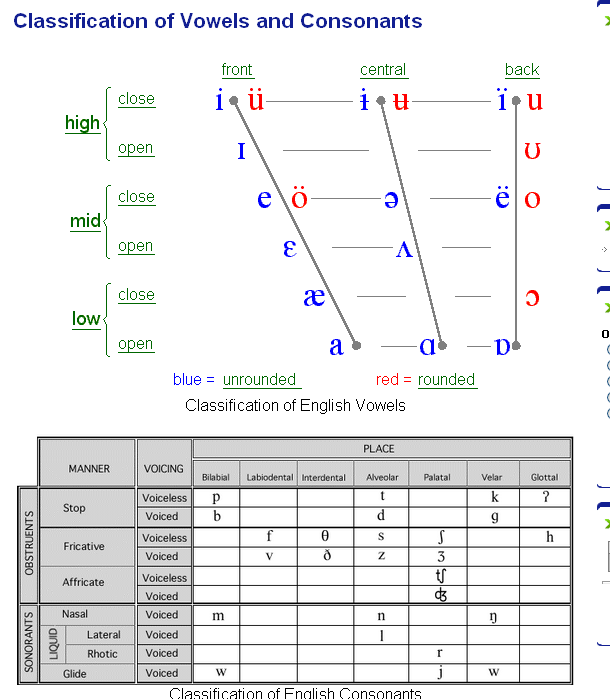

16. Classification of vowels
- Vowels are normally made with the air stream that meets no obstruction in the mouth, pharyngeal and nasal cavities.
- On the articulatory level the description of vowels notes changes:
1. in the stability of articulation
2. in the tongue position
3. in the lip position
4. in their length
The stability of articulation
All English vowels are divided into 3 groups: monophthongs, diphthongs, diphthongoids.
Monophthongs are vowels the articulation of which is almost unchanging.
They are – [i e ǽ a: o o: U Λ ə: ə ].
In the pronunciation of diphthongs the organs of speech glide from one vowel position to another within one syllable. The starting point, the nucleus, is strong and distinct.
They are – [ei ai oi au əu iə εə uə]
In the pronunciation of diphthongoids the articulation is slightly changing but the difference between the starting point and the end is not so distinct as it is in the case of diphthongs.
They are – [i: u:]
Tongue Position
The tongue may move forward, backward, up, down, thus changing the quality of vowels.
1. When the tongue is in the front part of the mouth and the front part of the tongue is raised to the hard palate a front vowel is pronounced.
They are – [i: e ǽ]
2. When the tongue is in the front part of the mouth but slightly retracted and the part of the tongue nearer to the centre than to front is raised, a front-retracted vowel is pronounced.
It is – [i].
3. When the front of the tongue is raised towards the back part of the hard palate the vowel is called central.
They are – [Λ ə: ə].
4. When the tongue is in the back part of the mouth and the back of it is raised towards the soft palate a back vowel is pronounced.
They are – [a: o o: u:].
5. When the tongue is in the back part of the mouth but is slightly advanced and the central part of it is raised towards the front part of the soft palate a back-advanced vowel is pronounced.
It is – [U].
Moving up and down in the mouth the tongue may be raised to different height towards the roof of the mouth.
1. When the front or the back of the tongue is raised high towards the palate the vowel is called close.
They are – [ i: I u u:].
2. When the front or the back of the tongue is as low as possible in the mouth open vowels are pronounced.
They are – [ǽ a: o o:].
3. When the highest part of the tongue occupies the position intermediate between the close and the open one mid vowels are pronounced.
They are – [e Λ ə: ə].
Lip Position
When the lips are neutral or spread the vowels are called unrounded.
They are – [i: i e ǽ a: Λ ə: ə].
When the lips are drawn together so that the opening between them is more or less round the vowel is called rounded.
They are – [o o: u u:].
Vowel Length
All English vowels are divided into long and short vowels.
Long vowels are – [i: a: o: u: ə:]
Short vowels are – [i e o u Λ ə]
17. CLASSIFICATION OF CONSONANTS
PRINCIPLES OF CLASSIFICATION
Consonants are made with air stream that meets an obstruction in the mouth or nasal cavities.
On the articulatory level the consonants change:
1. In the degree of noise.
2. In the manner of articulation.
3. In the place of articulation.
1. THE DEGREE OF NOISE
A. Noise Consonants
1. In the work of the vocal cords –
2. The degree of force of articulation –
B. Sonorants are
3. THE MANNER OF ARTICULATION
According to the manner of articulation consonants may be of 3 groups:
1. Occlusive
2. Constrictive
3. Occlusive-constrictive (affricates)
1.
Occlusive consonants may be PLOSIVES –
Occlusive consonants may be SONORANTS or NASAL –
2.
Constrictive consonants may be NOISE or FRICATIVES -
Constrictive consonants may be SONORANTS or ORAL –
3.
Occlusive-constrictive (affricates) are noise –
4. THE PLACE OF ARTICULATION
a) According to the position of the active organ of speech against the point of articulation (place of articulation) consonants may be:
1. Labial
